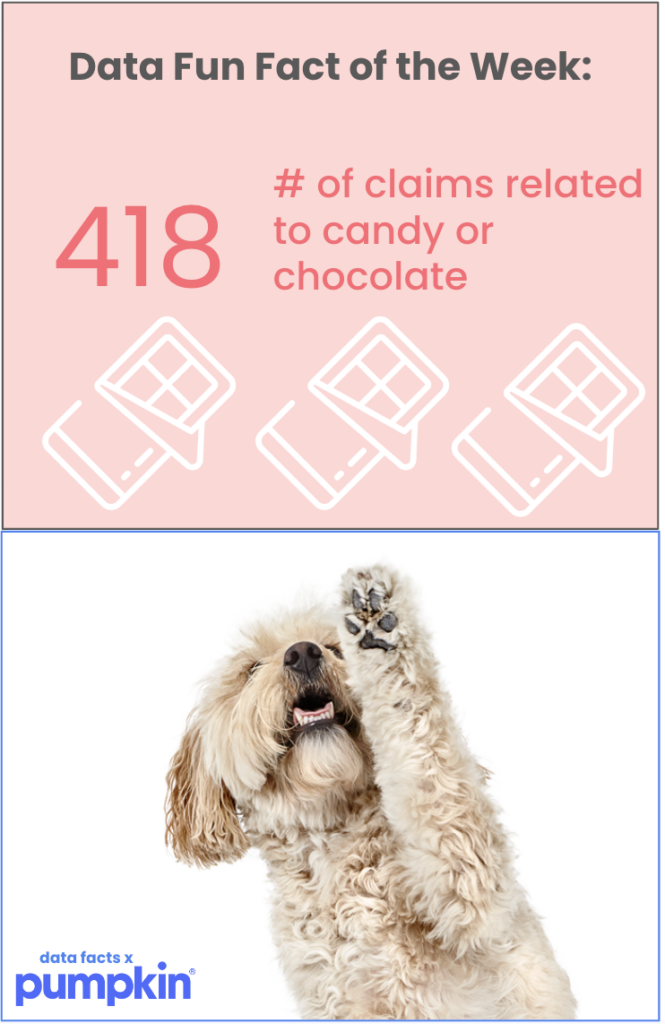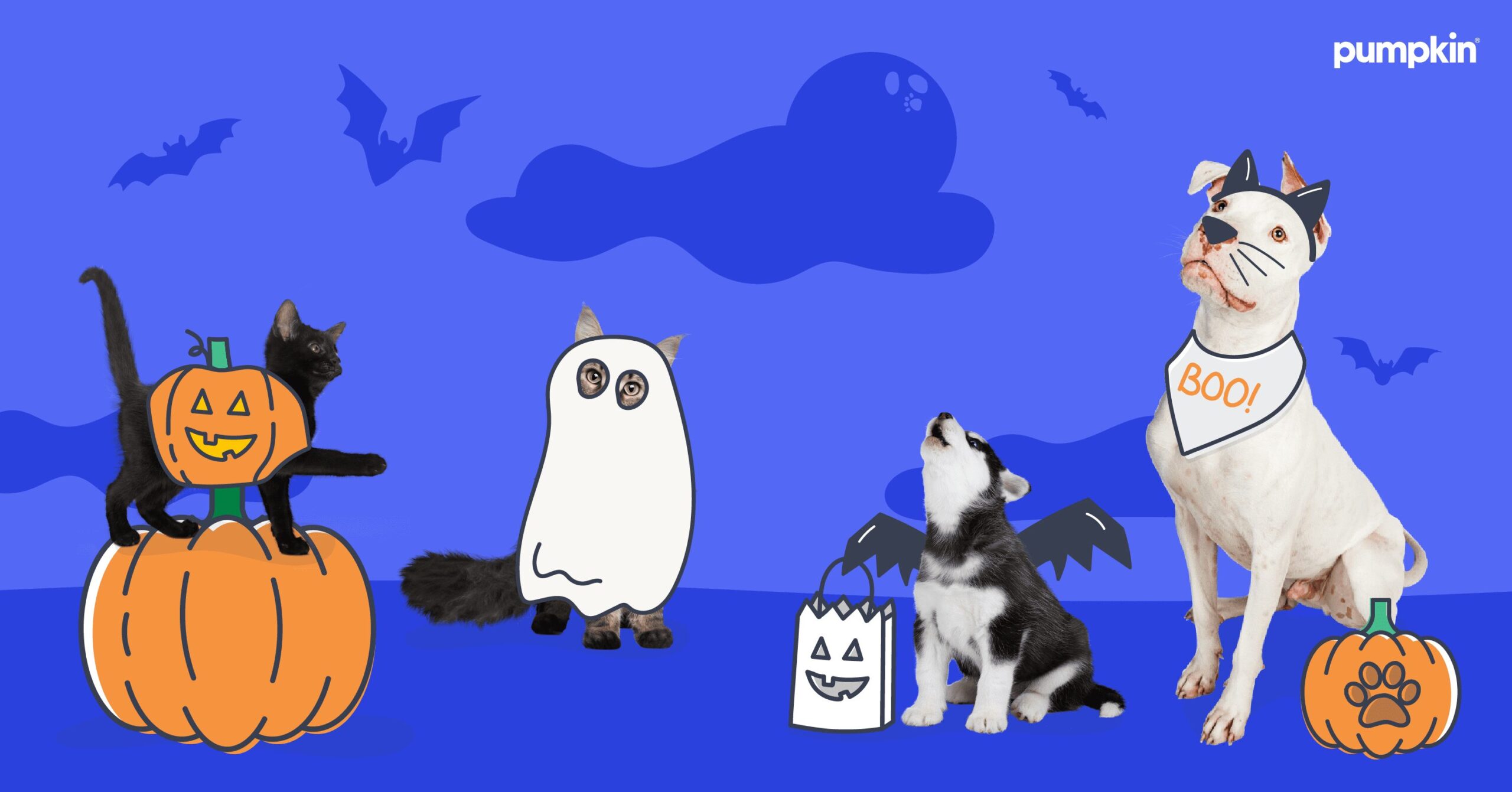Key Points
- From spooky decorations to sugary treats, the Halloween season can be full of potential dangers for your pet.
- Chocolate and artificial sweeteners can make your pet seriously sick, so be sure to keep your pup or cat away from your candy stash.
- Be conscious of choking hazards like candy wrappers, small decorations, and costume accessories — and if your pet hates dressing up, skip the costumes this year.
It’s Halloween night and festivities are in full swing: There’s candy to give out, spiderwebs adorn the doorway, and the trick-or-treaters are ready to ring your doorbell any minute. Your costumes are the stuff of nightmares — maybe you even dressed up your dog up as a creepy clown, or your cat is lurking around the corner ready to pounce. No matter how your fur family celebrates Halloween, it’s important to keep an eye on your pet.
With all the tricks and treats going on, your pet may not be the first thing on your mind during the spookiest night of the year. But remember, your pooch hasn’t been looking forward to this evening for all of October (and your cat probably doesn’t care what day it is). The ringing doorbell, motion-activated decorations, and pet parents in disguise can seriously scare your pet. Plus, curious pets may be extra keen to get into areas they shouldn’t, like buckets of candy or lit jack-o-lanterns.
While it’s easy to get caught up in the excitement of the holiday, remember to take some precautions to ensure your pets stay safe and healthy. Before your celebration begins, make sure you know the most common Halloween hazards for your pet and how to protect them. After all, an emergency vet visit is one of the scarier things Halloween night can bring.

Candy
Chocolate, gummies, and chews, oh my! Candy is one of the best parts about the Halloween season – as long you keep it far away from your pets.
Tip: Beware of chocolate and xylitol, an artificial sweetener that is toxic for dogs.
Halloween candy, while delicious, is not so nutritious for pets. Chocolate and sugar-free candy in particular are toxic to dogs, cats, and other animals. Xylitol, a common artificial sweetener in sugar-free candies like lollipops, is extremely toxic to dogs and cats and should not be ingested. Cupcakes or other tempting Halloween treats containing baking chocolate should also be kept away from areas your pet might find accessible.
Another important candy-related pet hazard to remember is candy wrappers. Dogs and cats may be attracted to shiny wrappers, causing a risky game that could result in the ingestion of a foreign object. Candy wrappers are choking hazards, and can cause serious health issues for your pet if ingested. The intestinal tract is not meant to process foreign objects like candy wrappers or small plastic toys. Be sure to keep Halloween baskets out of your pet’s reach.
Try this instead: Pumpkin is full of healthy fiber, so you can give your dog (or cat) a taste of plain, canned pumpkin as a seasonal treat. Just be sure to avoid artificial flavors and sweeteners.
If your pet does happen to get into candy, treats, or wrappers, contact your emergency veterinarian right away, or call the Pet Poison Helpline. If you’re unsure whether your pet ingested candy, be sure to monitor them for signs of drooling, pacing, vomiting, or diarrhea.

Costumes
Costumes, while absolutely adorable on pets, may cause unexpected issues. The first hazard to remember about Halloween costumes — both your pet’s costume and your own — is that any small buttons, appliqués, or bits of string can be too tempting for a curious pet. Cats or dogs might try to play with and accidentally ingest bits of the Halloween costume you plan to wear, so be sure to keep all spooky accessories out of your pet’s reach.
Along with the possibility of an unexpected choking hazard, you should also note that costumes may cause additional stress for anxious pets. While you may enjoy dressing your pet up for Halloween, they may feel differently and can’t let you know with words. Keep in mind that pets may become overstimulated by fabric from pet costumes, and keep an eye out for stressed behavior as a result.
Certified applied animal behaviorist Dr. Janet Cutler Ph.D., offers some valuable advice on the subject of pets and Halloween costumes:
“Dressing up your pet could result in anxiety or stress in your pet. While many pets might not be bothered at all, there are many who could show signs of distress. This includes trying to escape, or even the opposite where your dog or cat may lie down and not want to move at all. Watching your pets’ ears is important too – typically, dogs and cats will pull their ears back and down when experiencing stress or anxiety. If you’d like to try getting your pet into a costume for Halloween, then starting early is your best bet. Get them used to different elements of the costume slowly and give treats throughout to make it a good experience. You also don’t want to leave your pet unattended with a costume on in case they get stuck trying to remove it or ingest part of it.”
Try this instead: If you’re really hoping to dress your pet up for Halloween, you may want to try introducing costumes slowly and over time. Start out with a simple bandana or bow-tie collar attachment, and work your way up from there.
Decorations
Some Halloween decorations are seriously scary – but your pet getting into them when you’re not looking is even scarier.
From small plastic decor items to faux spiderwebs and fog machines, there are many decor-related hazards to avoid when decorating your home for Halloween. Remember that small items are choking hazards, so be sure to place any tiny decorations out of your pet’s reach.
Tip: Chewing on glow sticks, swallowing fake spiderwebs, and knocking over lit candles can all send your pet to the emergency vet. Consider pet insurance before you plan your Halloween party, so you’ll have a safety net in place to help you afford eligible vet bills if an accident happens.
This also rings true for motion-activated decorations or other items that need to be plugged in: electrical cords can be a potential fire hazard if your dog or cat chews them up. Jack-o-lanterns with lit candles are another fire hazard that should be kept out of reach of curious pets. Glow sticks and glow jewelry may also intrigue your pet, but the toxic chemicals inside can make your pup or cat seriously sick if they accidentally ingest it while chewing. All in all, be sure to prioritize your pet’s health over your party theme — it’ll make for an easier cleanup anyway.
Trick-or-treaters
The last thing anyone wants during Halloween night is a lost pet, which is especially important to remember while passing out candy to trick-or-treaters. To help keep your pets safe while passing out candy to trick-or-treaters, you might want to keep them in a separate and secure area of the house, with access to fresh water, food, and a litter box if applicable.
Tip: The constant ringing of your doorbell by spooky strangers may make your pet anxious or scared. Keep an eye on their body language!
Dr. Cutler seconds this opinion:
“The biggest risk for your pet when there are trick-or-treaters visiting is that they will cause fear in your pet. This could mean that your pet runs to hide, and there is a risk with the door opening often when you’re handing out candy that your pet could run out while fearful. It’s recommended to keep your pet away from all the action. This can keep them away from the dangers of open doors and the risk of them being very frightened from all the Halloween action. Having them closed in a room away from the action is recommended, and having a TV, radio, or white noise on to drown out some of the sound can be helpful. You can also keep your pet busy with food puzzles or food-dispensing toys.”
Keeping your pets safe and secure during a Halloween party or trick-or-treating is a great way to ensure a successful and fun night for you and your furry family members. If left to their own devices, a curious or stressed-out dog or cat may try to escape from an open door during trick-or-treating. Be sure that your pet is equipped with an ID tag and microchip if you plan to leave them around open doors.
Try this instead: If you don’t want to lock up your cat (or if your dog refuses to be contained), you can always leave candy at the front door and keep it shut, or even add a “Beware of Dog” sign to make it extra spooky!
The final word on protecting your pet this Halloween
To keep your pets safe this Halloween, be sure to choose pet-safe costumes and decorations, and keep your candy out of paw’s reach. If you have an anxious pet at home, consider adopting a hands-off approach to trick-or-treating. Halloween should be a fun event for everyone involved, and that includes your furriest family members.
By getting ahead of these potential dangers, you can set your pet up for a day of all treats and no tricks. And, if you’re looking for a little extra protection this spooky season, pet insurance can offer you some peace of mind when things get scary.




